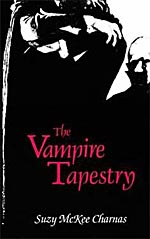
![]() charlesdee
charlesdee
10/20/2013
![]()
Susan McKee Charnas published her vampire novel in 1980. That was four years after Anne Rice had beguiled the American pubic with her romantic and sexed-up vampires. Charnas' effort must have seemed pretty dry stuff by comparison, but it garnered good reviews has had stayed stubbornly in print. And it is a remarkable piece of work: a vampire tale stripped or gothic trappings, sexual metaphors (although not of sex), and most all the traditional attributes writers attribute to undying bloodsuckers.
Dr. Edgar Wyland is not human. He lives by drinking the blood of his prey, and tracking that prey and overcoming that prey his is chief concern. Although he kills when he finds it necessary, he prefers to use the needle like projection under his tongue to take only what he needs to stay alive. His bite, even when fatal, does not produce new vampires. To his knowledge, he is the only one of his kind on earth. He has lived for centuries, and one of his greatest challenges is to learn, after a period of hibernation that may last for months or years, how to fit into the new society he encounters. The rapid advance of technology in the 20th century has made that transition trickier, but he does well for himself, taking on manual labor when nothing better presents itself.
In The Vampire Tapestry, he has reinvented himself as a distinguished professor of anthropology at a small New England University. His research there involves running a very convenient sleep clinic. Katje is the middle-aged widow of a professor who has been reduced to taking a job as a kitchen worker. She is Afrikaans, and people who apparently don't know how to read fiction write reader reviews where they object to her racist and sexist attitudes. But she was raised on a farm where blacks were beaten to keep them in their place – which seems to be euphemism for not deciding to kill their white overseers. She also thinks that those women who have been raped on campus probably didn't know how to take care of themselves, She is arrogant and ruthless, and she has figured out that Professor Weyland is a vampire. And she just may be his match. Their confrontation forces Weyland into his next life.
Charnas' narrative reads as much like linked short stories as a novel. We next find a weakened Weyland held captive by some creepy occultists in New York City who recognize what he is and plan to exploit him for some kind of ritual. Imagine how well that turns out. Then Weyland is in therapy, remanded into treatment by his old dean who wants to help rehabilitate his academic career. This is the strangest therapist/patient relationship ever recorded. Then Weyland takes a teaching position in Albuquerque, where he begins to set up business as usual only to meet impediments.
Weyland is interesting, compelling, and unsympathetic. It's not surprising that his new area of research is on the predator/prey relationship. All his interactions with humans, including the use of language, are learned behaviors that allow him to feed. In one of the novel's finest moments, he reflects on the admiral life of cats. They can sit for hours in relative stillness, enjoying the sun, and watching for their next meal. He longs to do the same and forego the intrusions of human interaction.
http://www.potatoweather.blogspot.com